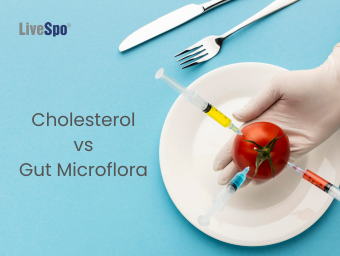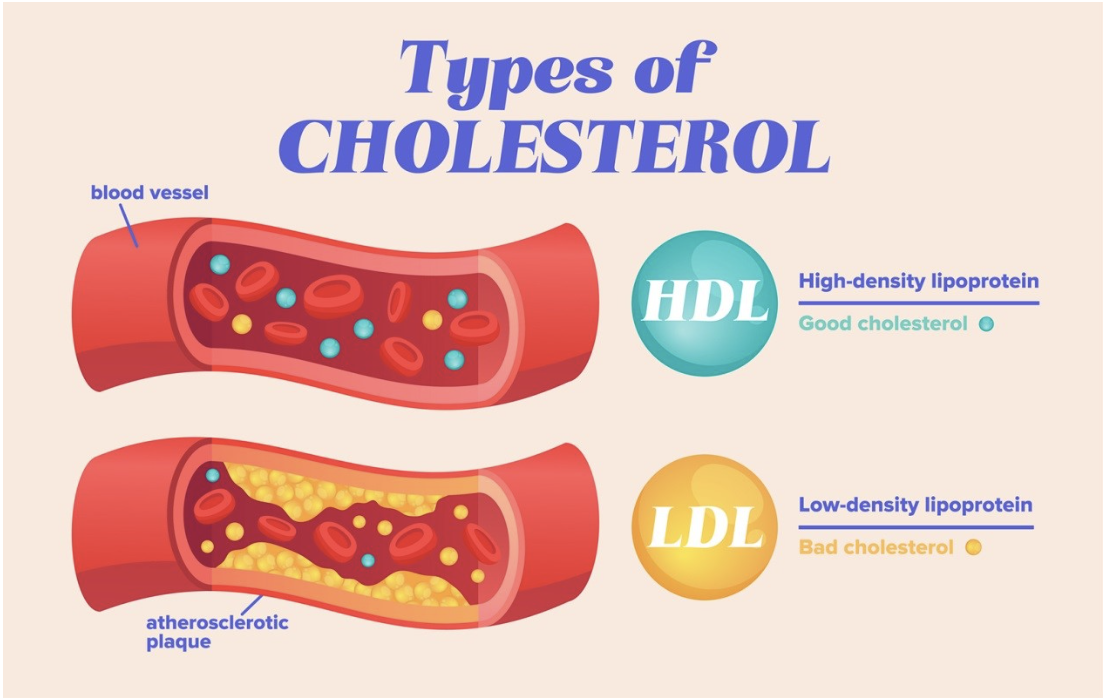How is the gut related to cholesterol? This question opens up more issues than you might think! While the digestive and cardiovascular systems are two distinct systems with different tasks, they are closely interconnected through the “gut-heart axis”. Taking good care of your gut microflora not only helps maintain healthy blood cholesterol levels for a strong and healthy body but also supports the function of a healthy cardiovascular system.
How do we define it?
The term “cholesterol” reflects a diet high in fats and clogged arteries. However, despite being commonly associated with negative effects, it is still an essential component of health. Therefore, we cannot live without “cholesterol”.
Recent studies have shed light on the relationship between cholesterol and gut microflora, leading to the disruption of our understanding of the effects and consequences of cholesterol on the human body. It’s no longer a simple matter of attributing all cholesterol-related accidents to one cause, but rather a complex interplay of genetics, dietary habits, lifestyle, and as you might suspect, the gut microflora.
Figure 1: The issue of excess cholesterol and its consequences (Source: City People Online)
If you’re pursuing a healthy cholesterol level, you can pay attention to your gut. However, before we can learn how to control it, we need to understand it. Let’s shed light on it together with the following information:
Understanding the pros and cons
Cholesterol is a waxy substance, a type of fat found in every cell of the human body, that performs several essential functions, including:
- Formation of cell membrane.
- Regulation of signal pathways and nerve transmission.
- Precursor to hormones, bile acids, and vitamin D [1].
Figure 2: Classification of cholesterol (Source: Bel Marra Health)
Referring to the function of the cardiovascular system, cholesterol isn’t the issue itself; the concern lies with the carriers (also known as lipoproteins) and where they transport cholesterol. These lipoproteins can be categorized into several types, with the most relevant types including:
- Good type of lipoprotein (HDL, High-density Cholesterol lipoprotein): These substances transport free cholesterol from our tissues to the liver through the intestine for excretion.
- Bad type of lipoprotein (LDL, Low-density Cholesterol lipoprotein): These substances transport cholesterol from the liver to tissues. A small amount is necessary, but excessive amounts can accumulate in the bloodstream and contribute to the formation of arterial plaque [2].
How does the gut microflora influence cholesterol levels?
Conversion to Coprostanol
Certain bacteria strains have been demonstrated to have the ability to convert cholesterol into a substance called coprostanol. Due to its structure, coprostanol is poorly absorbed through the intestinal mucosa and is easily excreted, making it an effective route for eliminating cholesterol. A significant amount of coprostanol is found in the healthy cholesterol association, leading researchers to believe that cholesterol-coprostanol-converted bacteria play a vital role in maintaining stable cholesterol levels in healthy individuals.
Bile acid breakdown
Bile acids are synthesized from cholesterol and form an essential part of the fat digestion process. While most bile acids are reabsorbed and recycled back to the liver, around 5% are metabolized by gut bacteria, providing another important route for cholesterol excretion.
Cholesterol trap
Several bacteria strains can act like vacuum cleaners, capturing cholesterol in the gut to form a part of their membrane. This process is believed to provide protective benefits to bacteria.
Figure 3: Certain strains of Lactobacillus and Bifidobacterium have shown effectiveness in relieving obesity and preventing weight gain (Source: Mekkes et al., 2014)
Although the regulation of cholesterol is a characteristic specific to each bacterial strain, the majority of these strains, primarily belonging to the genus Lactobacillus and Bifidobacterium, are native probiotics present in the human gut microflora [1]. Recently, there have been studies investigating the cholesterol-regulating potential of Bacillus coagulans.
Do you know…?
Roughly 80% of the body’s cholesterol is synthesized by the liver, while the remaining 20% comes from dietary sources. There is a relationship between diet microorganisms and cholesterol. One of the most effective ways to support a healthy microflora and cholesterol balance in the body is through a healthy dietary regimen, which is recommended by nutrient experts as follows:
- Fat: Consuming fewer saturated fats and more unsaturated fats (e.g., from food sources like salmon and olive oil) as opposed to saturated fats (e.g., animal products) has been shown to increase the population of beneficial gut bacteria, contributing to cholesterol balance.
- Fiber: Fiber-rich foods are not only excellent nutrients for humans but also serve as a form of our microflora. They not only slow down the absorption of sugar, fats, and cholesterol across the gut membrane but also encourage the growth and activity of beneficial bacteria. Food rich in both probiotics and fiber can help to reduce cholesterol levels, including whole grains (such as oats) and various fruits and vegetables.
- Plant Polyphenols: These are plant molecules known for their antioxidant properties and potential to support cholesterol metabolism and excretion. Think green tea, brightly colored fruits, vegetables, and red wine (just a little).
- Probiotics: Beneficial bacteria can be found in fermented foods like yogurt and can also be supplemented through biological products like probiotic supplements. Both sources of these bacteria have shown benefits in supporting a balanced gut microflora, as well as healthy cholesterol levels. Beneficial species include Bifidobacterium longum, Infantis, Bifidobacterium breve and Lactobacillus plantarum.
There is a shred of increasing scientific evidence demonstrating the connection between gut microflora and cholesterol. This is why taking care of the gut microflora is significantly important.
Reference:
[1] Kriaa A, Bourgin M, Mkaouar H, Jablaoui A, Akermi N, Soussou S, Maguin E, Rhimi M. Microbial reduction of cholesterol to coprostanol: an old concept and new insights. Catalysts. 2019 Feb;9(2):167.
[2] Elshourbagy NA, Meyers HV, Abdel-Meguid SS. Cholesterol: the good, the bad, and the ugly-therapeutic targets for the treatment of dyslipidemia. Medical Principles and Practice. 2014;23(2):99-111.
[3] Singh RK, Chang HW, Yan DI, Lee KM, Ucmak D, Wong K, Abrouk M, Farahnik B, Nakamura M, Zhu TH, Bhutani T. Influence of diet on the gut microbiome and implications for human health. Journal of translational medicine. 2017 Dec;15(1):1-7.
[4] Rajkumar H, Mahmood N, Kumar M, Varikuti SR, Challa HR, Myakala SP. Effect of probiotic (VSL# 3) and omega-3 on lipid profile, insulin sensitivity, inflammatory markers, and gut colonization in overweight adults: a randomized, controlled trial. Mediators of inflammation. 2014 Oct;2014.
[5] Chambers KF, Day PE, Aboufarrag HT, Kroon PA. Polyphenol effects on cholesterol metabolism via bile acid biosynthesis, CYP7A1: a review. Nutrients. 2019 Nov;11(11):2588.








